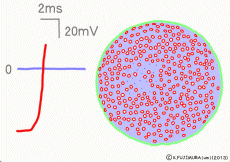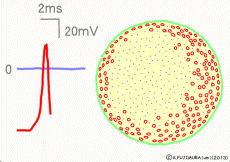[021] Action potential (GB#113A01) | 基礎医学教育研究会(KIKKEN)Lab

● Is cell excitement visible?
At this moment when we are alive, every moment’s event depends on invisible “electrochemical” power. Among them, the action potential is unusual for the cell’s electric phenomenon, and there may be a “shape” that is tactile, rather it may be “visible”
–
Contents
●excited cells
Among the cells that make up our bodies, neural cells and muscle cells, in particular, strongly generate unique electrical signals. It is a signal called action potential, and the state where this signal is generated is called cell excitation. Even saying “excitation” does not steam or turn red. As muscle cells contract as they get excited, we know that they are excited, but excitation is a phenomenon before muscle contraction, so we do not see cell excitation itself.
● Because it is an invisible signal, we are concerned about the shape
 Action potential is a temporary reversal phenomenon of cell membrane potential. People who are unfamiliar do not know “cell membrane potential”. All living cells are different in “voltage” between the outside and the inside of the cell membrane. To be accurate, however, the “voltage” is only large / small, but the direction of the voltage is different between the outside and the inside of the cell. The outside of the cell is positive and the inside is negative。 Such terms are distinguished by using the word “electric potential” as a technical term. Therefore, the state of electricity sandwiching the cell membrane is called “membrane potential”. Furthermore, since the membrane potential is a promise to measure intracellularly with reference to the outside, it means that the usual “membrane potential is negative”. (Outside the cell membrane is zero.)
Action potential is a temporary reversal phenomenon of cell membrane potential. People who are unfamiliar do not know “cell membrane potential”. All living cells are different in “voltage” between the outside and the inside of the cell membrane. To be accurate, however, the “voltage” is only large / small, but the direction of the voltage is different between the outside and the inside of the cell. The outside of the cell is positive and the inside is negative。 Such terms are distinguished by using the word “electric potential” as a technical term. Therefore, the state of electricity sandwiching the cell membrane is called “membrane potential”. Furthermore, since the membrane potential is a promise to measure intracellularly with reference to the outside, it means that the usual “membrane potential is negative”. (Outside the cell membrane is zero.)
・The mechanism by which the membrane potential is generated is a bit confusing to put out here, so to explain it is another opportunity to explain m(_ _)m.
 The action potential is the phenomenon that the membrane potential reverses and “becomes positive only for a moment”. But electric phenomena are invisible. Therefore, the flow (change in time) of the potential change is indicated using a special measuring device (amplifier with weak voltage change) and it is observed as a form of action potential. The most standard form is found in most textbooks
The action potential is the phenomenon that the membrane potential reverses and “becomes positive only for a moment”. But electric phenomena are invisible. Therefore, the flow (change in time) of the potential change is indicated using a special measuring device (amplifier with weak voltage change) and it is observed as a form of action potential. The most standard form is found in most textbooks![]() It is this figure. A sharp tower is popping out from a low place. The horizontal axis represents time, and time usually flows from the left side to the right side. It is only a moment for the potential to reverse (from negative to positive). In this figure we show the events of only 10 msec from end to end as a whole. The vertical axis is the amplitude, the height of the tower up to the top is probably about 100 millivolts. Both units have a prefix of milli. 1 millisecond is 1 / 1,000th of a second, 1 millivolt is 1 / 1000th of 1 Volt. 10 msec is one hundredth of a second, and 100 mV is one tenth of a volt. This is the form of the signal when the nerve cell is excited roughly.
It is this figure. A sharp tower is popping out from a low place. The horizontal axis represents time, and time usually flows from the left side to the right side. It is only a moment for the potential to reverse (from negative to positive). In this figure we show the events of only 10 msec from end to end as a whole. The vertical axis is the amplitude, the height of the tower up to the top is probably about 100 millivolts. Both units have a prefix of milli. 1 millisecond is 1 / 1,000th of a second, 1 millivolt is 1 / 1000th of 1 Volt. 10 msec is one hundredth of a second, and 100 mV is one tenth of a volt. This is the form of the signal when the nerve cell is excited roughly.

● Action potential is small but big
Of course, this signal is fairly small in terms of the sense of human daily life. Let’s see what it is for the cell. This electrical signal is the fluctuation that occurs inside and outside the cell across the cell membrane. The thickness of the cell membrane is roughly 10 nm (10 nanometers = 10 x 10 -9 m), and a signal of 100 mV is generated across it. To what extent is this, let’s say that the cell membrane is copy paper on hand. A slightly thick copy paper is approximately 100 μm thick (100 × 10 -6 m) thick. It becomes 100 × 10 -6 / 10 × 10 -9 = 10 × 10 3, that is, it becomes ten thousand times as compared with the actual cell membrane . Therefore, assuming that the size of the signal is also 10,000 times if the copy paper is a cell membrane, it becomes a value greatly deviating from everyday life of 1/10 × 1 × 10 thousand = 1000 V. It is the same as applying a voltage of 1000 V across a sheet of copy paper. As this changes even more in an instant, cell excitement seems to be an incredibly severe major incident.
● Action potential does not leave behind.
The amazing property of cell excitation, however, is that it is such a violent signal but hardly affects the cells, and it comes back to the original without any problems. Something seems to scorch if 1000 volts is applied across the copy paper. If not repeating this signal many times if it is not so, will any cell somewhere break? Although it is a big concern to worry, cells repeat action potentials unchanged thousands of times and tens of thousands times. Of course, repeating tens of thousands of times will have some effect, but it is a physiological effect that promotes cell differentiation and growth reactions, and it does not damage cells. When electricity dameges a cell, it is primarily the amount of electricity flowing, the magnitude of the current, it is not so if only the magnitude of the voltage. The amount of electricity actually flowing at the action potential is not much.
※ Calcium action potential plays an important role in the amount of calcium ions (Ca 2+) flowing.
● Action potential is like a chain reaction baton
The action potential is an electrical event, but it is not the purpose of working with electric power (electricity) like turning on lights or turning motors. It is not to move things in cells by the power of electricity or react them. This is like a “procedure” that spreads the same reaction to the cell membrane one after another as a chain reaction. Can you say that it is like a relay competition baton? However, runners of this relay will not run (?). Although they do not run, It seems like a game that passes through batons of action potential one after another in numerous ion channels (especially voltage-gated sodium ion channels) that are scattered and buried in the cell membrane, while staying there, to another nearby channel. (It may be better to have a sitting message game.) This voltage-dependent sodium ion channel changes shape and properties momentarily on the spot when receiving a signal of potential change. This ion channel is closed most of the usual time so that ions do not flow. But that channel is “open” for a moment.
The ion channel has the effect of changing the potential when it opens. This causes the potential to change. As the potential changes, another group of ion channels change. That is, the opened ion channel passes the baton to another group of ion channels. One group passes another baton of potential change to another group. The open ion channel also closes. It automatically returns to the ready state to receive the next baton. In this way, changes in the ion channel spikes throughout the cell in an instant. The change is a signal. If the opening and closing of the ion channel is visible (although it can not actually be seen), it will appear ![]() as it spreads throughout the cell membrane repeatedly.
as it spreads throughout the cell membrane repeatedly.
Actually, there are not many exciting cells in just such a round cell. Because cell excitation is a mechanism to extend the chain reaction, it exerts its power as a fibrous cell. This is the only way to broaden the signal from end to end of nerve fibers and elongated muscle fibers in a stroke. It is called conduction of excitation that excitation is transmitted in elongated cells. In order for us to live and move normally, action potential and conduction of its excitation are indispensable signals. The mechanism of conduction of excitation will be explained further on another occasion.
* The negative potential state inside the cell when not excited is referred to as “resting membrane potential”. The mechanism of the resting membrane potential and the movement of the ion channel is explained on another occasion.
* Electric eel also uses the action potential as a weapon that makes nearby prey numb. The action potential of the eel has sometimes the ability to faint a crocodile that caught. However, such a thing is a special usage. .
○ Related articles
◆[024] voltage-dependent sodium channel ![]()
◆[040] シナプス伝達 neural signal transmission ![]()
◆[036] ligand-gated ion channel ![]()
◆[031] 興奮伝導 conduction of excitation ![]()
◆[028] resting membrane potential ![]()
◆[044] 伸張反射 stretch reflex ![]()
◆[013] 細胞膜の脂質二重層 lipid bilayer of the cell membrane ![]()
◆[004] 陽イオンと陰イオン(1)引力と反発力,cation and anion, attraction and repulsion ![]()
◆[041] 心筋線維 myocardial fiber ![]()
○ Referenced books
・臓単―ギリシャ語・ラテン語 (語源から覚える解剖学英単語集 (内臓編))
・カラー図解 人体の正常構造と機能 全10巻縮刷版,坂井 建雄,日本医事新報社
・人体機能生理学,杉 晴夫,南江堂
・細胞の分子生物学, ニュートンプレス; 第5版 (2010/01)
・トートラ人体解剖生理学 原書8版,丸善
・イラスト解剖学,松村 讓兒,中外医学社
・柔道整復学校協会編「生理学」,南江堂
・東洋療法学校協会編「生理学」,医歯薬出版株式会社
rev.20140705, rev.20160611, rev.20170211,rev.20170504, rev.20171218.
KISO-IGAKU-KYOIKU-KENKYUKAI(KIKKEN)







